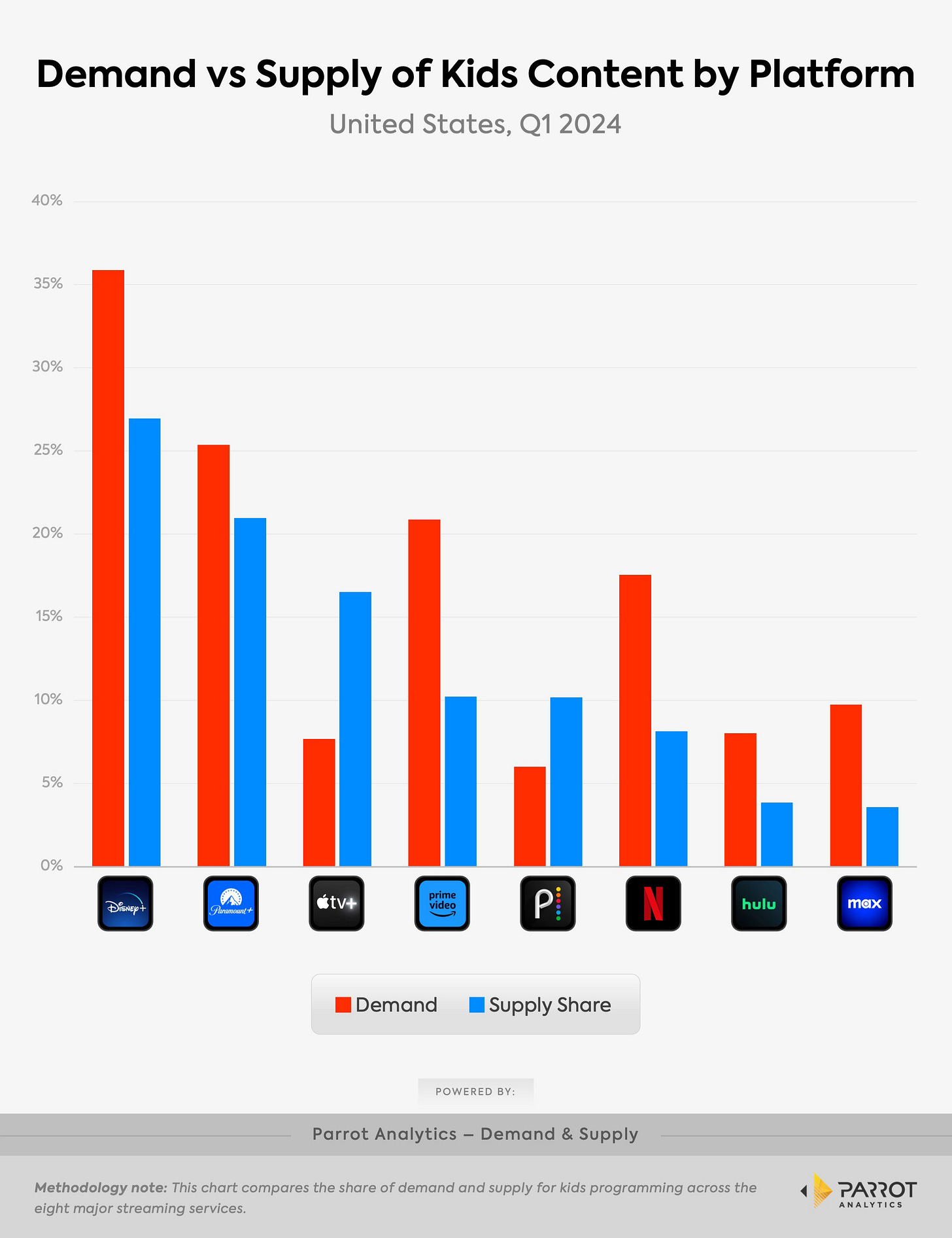Streamers and the Under-Tapped Potential of Kids Content
Why are streamers undervaluing children's programming?
In the ever-evolving landscape of streaming entertainment, one genre holds a unique and powerful potential—children's programming.
As it turns out, children’s programming is consistently in high demand, but low supply in the United States.
How do we know this? After all, “demand” in media is a nebulous concept, considering the rapid proliferation of content distribution platforms and extraordinary levels of consumer fragmentation.
But interestingly, Parrot Analytics utilizes a comprehensive approach to determine what demand for content drives consumption on all streaming platforms. They comb multiple “demand expression platforms”—including video streaming platforms, social media platforms, photo sharing platforms, blogging and micro-blogging platforms, fan and critic rating platforms, peer-to-peer protocols and file sharing platforms.
The results of their most recent Q1 2024 report support that most of the industry should implement more children’s programming when examining the demand versus supply ratio broken down by streaming platform.
As platforms like Disney+, Paramount+, Amazon Prime Video, Netflix, Hulu, and Max demonstrate, there is a clear gap between what is available and what is needed. Apple TV+ and Peacock might be over-indexed within the genre, but the majority could use a boost in their kids' content libraries.
Streamers may be under-indexing on children’s programming because of the unique traits of young audiences.
Children's content has the unique advantage of needing less volume to maintain engagement. Young kids, unlike adults, enjoy repeated viewings of their favorite shows and characters, which means streaming services can keep them entertained with a smaller library of content.
This loyalty to familiar franchises ensures that children remain regular viewers, reducing the need for streamers to continually create or license new material.
Moreover, children form a distinctive audience within the entertainment industry. Due to age-specific advertising regulations, direct marketing to kids is often restricted. However, their tendency to repeatedly watch the same content makes them incredibly loyal viewers.
Nonetheless, in an era where streaming platforms are keen to attract new subscribers and reduce churn, creating a robust collection of family-friendly content is a strategic move to retain paying members (i.e., the parents).
With the research demonstrating the existing gap to indicative demand, streamers should recognize the potential for achieving more revenue and brand loyalty by producing more quality kids content.
Kids programming requires different strategies than adult programming to achieve sustainable success.
In recent times, Netflix has quietly scaled back from kids programming after some children’s properties haven’t found wide-scale success on the platform. When kids’ tv creator Chris Nee’s overall deal with the streamer was not renewed in 2024, she shared her beliefs as to how Netflix and other streamers might be hurting their business by not understanding kids’ content. Specifically:
The algorithm intentionally avoids pushing the same thing twice. While this may appeal to adults seeking variety, it overlooks the fact that rewatching is essential for younger kids. On average, children might watch the same episode of a beloved show like Blue's Clues multiple times in a row. A more effective strategy would be to keep kids' favorite shows on their main page for a set period, ensuring easy access.
The lack of brand identity among many streamers leads to a diluted identity. Disney has a strong, recognizable brand with characters like Mickey Mouse, but many other platforms promise something for everyone while failing to make a lasting impression in the kids space. Establishing a strong brand identity is essential for drawing in young viewers and creating long-term engagement.
Merchandising plays a significant role in children's content. It's not just about additional revenue; it's about expanding a child’s relationship with the show. However, manufacturers want to see longevity in a property before committing to producing toys, clothes, and other merchandise. Constantly commissioning and canceling programs, as streamers have a tendency to do, make it challenging to achieve this stability.
Streamers fall short in effective marketing and promotion for kids content. The decision-making around which shows and episodes are strongly promoted by their host platforms is opaque, with some kids series receiving minimal boosts to improve audience awareness. Strong marketing has the ability to make a significant difference in a show's success and longevity.
The Future of Kids' Programming on Streaming Platforms
At Moonbeam, we see a tremendous opportunity in developing quality children's content that speaks to diverse audiences. Streamers need to recognize the importance of patiently nurturing new properties, building strong brand identities, and effectively marketing their shows. By doing so, they can establish a lasting connection with the next generation of viewers, driving growth and innovation in the industry.
As the landscape of kids' content continues to evolve, we're excited to be part of the conversation and to contribute to the creation of diverse, engaging, and impactful programming for children around the world.
Sincerely,
Jesse & Rebecca





